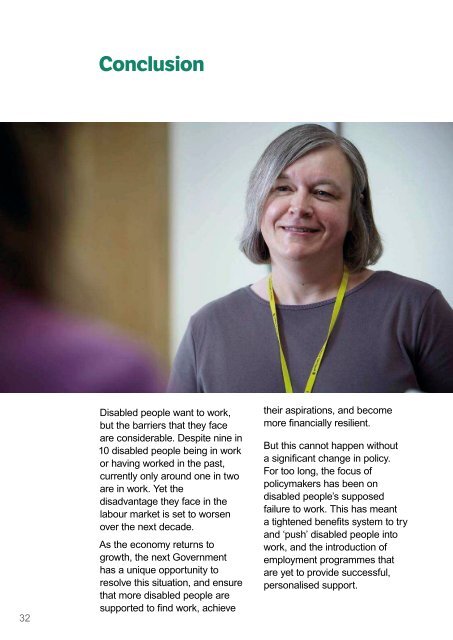A-million-futures-halving-the-disability-employment-gap.pdf?ext=
A-million-futures-halving-the-disability-employment-gap.pdf?ext=
A-million-futures-halving-the-disability-employment-gap.pdf?ext=
Create successful ePaper yourself
Turn your PDF publications into a flip-book with our unique Google optimized e-Paper software.
ConclusionTo resolve this, it is essential thatall political parties base <strong>the</strong>irpolicy development on a moresophisticated understanding of<strong>the</strong> barriers to work that disabledpeople face.The biggest change must be torecognise that many disabledpeople want to work and alreadydo – and that <strong>the</strong> challenge for<strong>the</strong>m is to have job that has <strong>the</strong>flexibility <strong>the</strong>y need to remain inwork. A refreshed approach tosickness absence and better,more flexible in-work supportis essential in order to supportmore disabled people to excelat work.Finally, policy around<strong>employment</strong> support shouldrecognise that disabled peopleface considerable social andenvironmental barriers to work.This must be taken into accountin assessments of ‘fitness forwork’. And if <strong>the</strong> supportprovided for unemployeddisabled people is to becomemore effective, it must startfrom <strong>the</strong> individual andprovide a more personalised,tailored service.Disabled people want to work,but <strong>the</strong> barriers that <strong>the</strong>y faceare considerable. Despite nine in10 disabled people being in workor having worked in <strong>the</strong> past,currently only around one in twoare in work. Yet <strong>the</strong>disadvantage <strong>the</strong>y face in <strong>the</strong>labour market is set to worsenover <strong>the</strong> next decade.<strong>the</strong>ir aspirations, and becomemore financially resilient.But this cannot happen withouta significant change in policy.For too long, <strong>the</strong> focus ofpolicymakers has been ondisabled people’s supposedfailure to work. This has meanta tightened benefits system to tryand ‘push’ disabled people intowork, and <strong>the</strong> introduction of<strong>employment</strong> programmes thatare yet to provide successful,personalised support.A second major policy shift mustbe to recognise that <strong>the</strong> shapeof <strong>the</strong> labour market is creatingchallenges for disabled people.More jobs should be targetedat disabled people in <strong>the</strong>ir localarea, and central Governmentshould incentivise City Regionsto provide significantly bettersupport for disabled peopleto take advantage of growth.As <strong>the</strong> economy returns togrowth, <strong>the</strong> next Governmenthas a unique opportunity toresolve this situation, and ensurethat more disabled people aresupported to find work, achieve32 33


